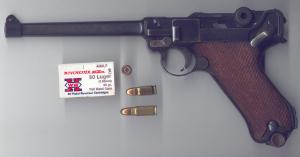 |
Left side of a 1923 Commercial Luger. This specific example is chambered for the
7.65 Parabellum, and has a six-inch barrel. Note the C/N proof on the left of the
barrel extension. Also pictured is the end flap from a current production box of
Winchester .30 Luger ammunition.
There are also three rounds of ammunition in the picture. From top to bottom, these
are: 1) a round of Winchester .30 Luger set so the cartridge headstamp can be seen,
2) a round of Winchester .30 Luger set on its side so it can be seen as a 7.65x21
bottlenecked cartridge, and 3) a round of 7.63x25 Mauser (.30 Mauser) ammunition.
I have included the round of 7.63x25 Mauser because people unfamiliar with either
Lugers or Mauser C96 "Broomhandles" sometimes confuse the .30 Luger and
the .30 Mauser cartridges. Shooters new to .30 Luger chambered pistols have been
known to see bargain basement prices on military surplus 7.62x25 and, thinking .30
Mauser is just another name for .30 Luger, buy this ammunition by the case lot to
fire in their Lugers. They are disappointed to find a .30 Mauser cartridge will not
chamber in a .30 Luger pistol. Shooters new to .30 Mauser C96's sometimes make the
same mistake in reverse, and buy .30 Luger for use in their C96's. Alas, the .30
Luger cartridge will feed and fire in a .30 Mauser C96 - frequently to the detriment
of the C96. |
| |
|
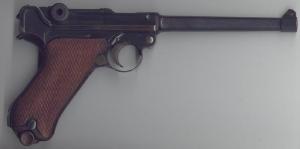 |
Right side of the same 1923 Commercial Luger. Note the absence of any Imperial Army
acceptance or proof marks on the barrel extension. While the 1923 Commercial variation
is usually regarded as being of completely new, post-war manufacture, it is not rare
to find scrubbed Great War Luger parts used to assemble 1923 Commercials. This pistol
in particular is an example of this. The receiver ring of this pistol's barrel extension
shows noticeable thinning on top, indicating something (probably a date) was removed.
This removal was done carefully, and the receiver ring shows a graceful curve - unlike
the same part in the 1923 Finnish contract Luger also pictured here in the Owners'
Corner. |
| |
|
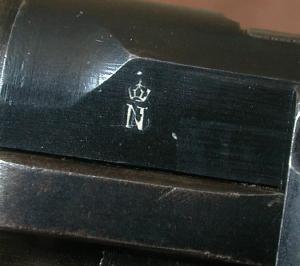 |
Close-up photograph of the C/N barrel extension proof. |
| |
|
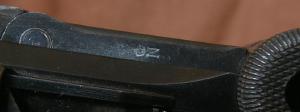 |
Close-up photograph of the "lazy" C/N proof on the first toggle link. The
breechblock is not proofed. |
| |
|
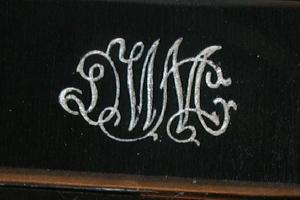 |
Close-up of the DWM monogram on the first toggle link. |
| |
|
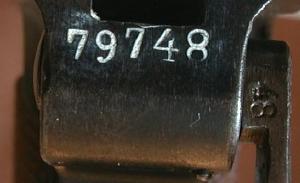 |
Close-up photograph of the frame serial number. The photo was taken with the takedown
lever extended into the disassembly position so the serial number on the bottom of
the takedown lever is visible. In the commercial serial number placement, the serial
numbers on small parts were placed on the side rather than the top of parts, to avoid
visually cluttering the graceful lines of the pistol with markings. |
| |
|
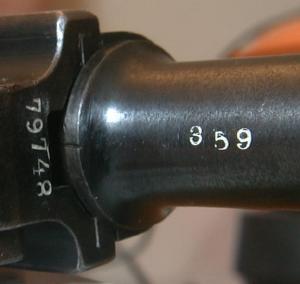 |
The six-inch barrel on this specific 1923 Commercial is not proofed, and is marked
only with the number "359." The origin and significance of this number
is unknown. While this number is not related to the pistol's serial number, it is
of the same style and placed in the same manner as the barrel number on the 1920
Commercial Artillery also pictured here in the Owner's Corner. The similar number
on the 1920 Commercial Artillery does match the pistol's serial number, providing
us food for thought and (no doubt some spirited speculation).
Here is the US during the 1920's Pacific Arms was known for its importation of Lugers
to be sold commercially, and is thought to have furnished and installed many of the
longer length barrels found on its Lugers. It is possible this is a Pacific Arms
imported Luger. Note, however, this Luger is not marked "Germany" as were
most of the Lugers made for export from Germany to the US. |
| |
|
 |
Close up of the (mismatched) wood magazine bottom on this pistol's magazine. This
appears to be the spare magazine (note the "+" sign) to a Great War Imperial
Luger, serial number 3161. It is not known whether this magazine was originally delivered
with this Luger. |
| |
|
| Photos Courtesy of Kyrie Ellis |







